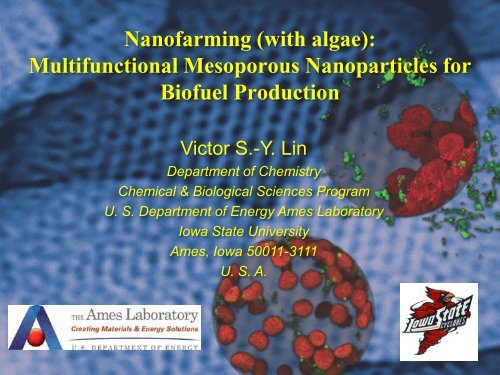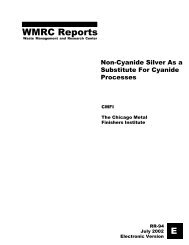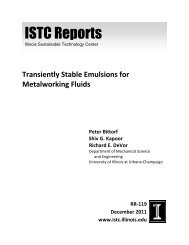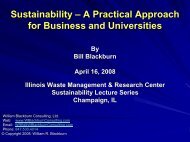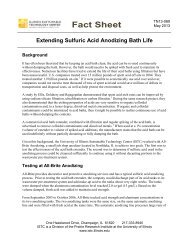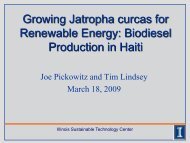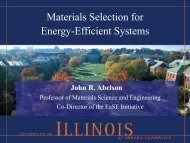Nanofarming (with algae): Multifunctional Mesoporous ...
Nanofarming (with algae): Multifunctional Mesoporous ...
Nanofarming (with algae): Multifunctional Mesoporous ...
Create successful ePaper yourself
Turn your PDF publications into a flip-book with our unique Google optimized e-Paper software.
<strong>Nanofarming</strong> (<strong>with</strong> <strong>algae</strong>):<br />
<strong>Multifunctional</strong> <strong>Mesoporous</strong> Nanoparticles for<br />
Biofuel Production<br />
Victor S.-Y. Lin<br />
Department of Chemistry<br />
Chemical & Biological Sciences Program<br />
U. S. Department of Energy Ames Laboratory<br />
Iowa State University<br />
Ames, Iowa 50011-3111<br />
U. S. A.
Global Warming?<br />
Upsala Glacier in Argentina
The Debate is Over …<br />
from Bob Willard<br />
www.sustainabilityadvantage.com
From Biological Feedstocks to Energy<br />
Different Resources<br />
New Technologies<br />
Different Applications<br />
Food<br />
Municipal Waste<br />
Animal Feed<br />
Short Rotation Trees<br />
Electricity<br />
Agricultural Crops,<br />
Grasses, Algae, and<br />
Residues (biomass)<br />
Biofuels (Ethanol<br />
& Biodiesel)<br />
Hydrogen<br />
Need new Refinery Methods for converting non-food resources into feedstocks.<br />
Need new Catalysts that works at new interfaces.
Conversion of Oil to Biodiesel<br />
Oil (Triglyceride)<br />
Methyl Esters<br />
Biodiesel<br />
Glycerol<br />
Glycerin
6<br />
Advantages of Biodiesel<br />
• Meets health effect testing (CAA – Clean Air Act)<br />
• Lower emissions (VERY low/no N or S)<br />
• High flash point (>300F)<br />
• Biodegradable, essentially non-toxic<br />
• Can be used in existing diesel engines<br />
• Excellent lubrication properties<br />
• Can use existing fuel distribution networks
Biodiesel Production Plants in 2006
U.S. Represents Two Billion Gallons of<br />
Biodiesel Capacity<br />
8<br />
ISU
Biodiesel Production Today<br />
Feed Oil<br />
Drying<br />
Esterification<br />
Transesterification<br />
Neutralization<br />
Water Wash<br />
Uses Non-renewable Catalyst<br />
(Sodium Methoxide or<br />
Sodium Hydroxide)<br />
Water washing<br />
and Neutralization<br />
is necessary<br />
Biodiesel<br />
Recovery<br />
Low quality<br />
Glycerin<br />
High quality<br />
Glycerin<br />
Catalyst contaminates<br />
glycerin co-product<br />
Methanol<br />
Residual water must be<br />
distilled from methanol<br />
Toxic Waste<br />
Not all methanol recovered
U.S. Produces Biodiesel from Vegetable Oils<br />
10
Problems of<br />
Free Fatty Acid (FFA)-Containing Feedstock<br />
Animal Fat, Algae<br />
or Waste Oil<br />
Base catalyst destroyed<br />
by FFA’s (soap formation)<br />
Biodiesel<br />
Esterification<br />
by acid catalyst<br />
FFA Free Oil<br />
Transesterification<br />
by base catalyst<br />
Free Fatty Acid<br />
We need a solid material that can catalyze both reactions!
Oil Feedstocks for Making Biodiesel<br />
Table from: Y. Chisti, Biotechnol. Adv. 2007, 25, 294-<br />
306.<br />
• U.S. currently uses ~970 million acres for crops & grazing<br />
• ~16.4 trillion acres of soybean would be needed for supplying ALL U.S.<br />
transportation fuel.<br />
• Only ~20 million acres of <strong>algae</strong> could supply the same amount of biodiesel, i.e., only<br />
2.2 % of the existing U.S. cropping area would be needed
Oil Content of Micro<strong>algae</strong><br />
Micro<strong>algae</strong><br />
Table from: Y. Chisti, Biotechnol. Adv. 2007, 25, 294-306.
Green Micro<strong>algae</strong>: Botryococcus braunii (Bb)<br />
14
Algae Continues to Garner R&D Interest and<br />
Funding<br />
15
Open Pond vs. Photobioreactor<br />
Paddle wheels for mixing<br />
General Atomics<br />
Cyanotech Corp. in Hawaii<br />
Solix Biofuels<br />
16
From Algae to Biodiesel<br />
Select<br />
Strain<br />
Picture modified from “The Fuel Cell”, Popular Science, 271(1), July 2007, Page 76-101.
Hydrocarbons from Green Micro<strong>algae</strong><br />
Ether Lipid & Triglyceride<br />
Fatty Acids<br />
Alkenes<br />
Sterols<br />
Botryococcus braunii (Bb)<br />
(Race-A from U.K.)<br />
Ref: (a) P. Metzger et al. Appl. Microbiol Biotechnol. 2005, 66, 486-496.<br />
(b) N. O. Zhila et al. Russ. J. Plant Physiol. 2005, 52, 357-365.
19<br />
Current Challenges<br />
• Only short chain (< C20), non-branched hydrocarbons<br />
are economical feedstocks for fuel production.<br />
• Current oil extraction methods cause fatal damages to the<br />
cell growth of most, if not all, <strong>algae</strong>.<br />
• Lack of efficient and economical refinery methods for<br />
the isolation of the suitable fuel feedstocks from the<br />
“alphabet soup” of hydrocarbons from <strong>algae</strong>.<br />
• Current commercial catalysts (e.g. NaOMe) for biodiesel<br />
production cannot handle the impurities, such as free<br />
fatty acids and lipid phosphoric acids, of <strong>algae</strong> oil.
Nanotechnology for<br />
Extraction, Separation, and Fuel Production<br />
20<br />
Select<br />
Strain<br />
<strong>Nanofarming</strong>
21<br />
Our Approach to Overcome these Challenges<br />
• Develop non-invasive oil extraction methods <strong>with</strong><br />
high recyclability and regrowthability of <strong>algae</strong>.<br />
• Design new sequestration method for selective<br />
isolation of the suitable fuel feedstocks from the<br />
hydrocarbons of <strong>algae</strong>.<br />
• Construct solid catalysts for efficient production of<br />
biodiesel from <strong>algae</strong> oils <strong>with</strong> fatty acids.
Our Approach:<br />
Introduce functional groups that are electrostatically or hydrophobically attractive to<br />
the ammonium surfactant head groups and able to compete <strong>with</strong> silicate anions.<br />
Aqueous Phase<br />
H 2 O<br />
H 2<br />
Hydrophobic Core<br />
of Surfactant Micelle<br />
Lin, V. S.-Y.; Lai, C.-Y.; Huang, J.; Song, S.-A.; Xu, S. J. Am. Chem. Soc. 2001, 123, 11510-11511.<br />
Huh, S.; Wiench, J. W.; Yoo, J.-C.; Pruski, M., Lin, V. S.-Y. * Chem. Mater. 2003, 15, 4247-4256.<br />
Huh, S.; Wiench, J. W.; Trewyn, B. G.; Pruski, M.; Lin, V. S.-Y. * Chem. Comm. 2003, (18), 2364 - 2365
Interfacial Hydrophobic and Electrostatic Interaction<br />
between Organosilicates and Micellar Surfactants (CTAB)<br />
R = Hydrophobic Functional Groups<br />
R 1 = Hydrophilic Functional Groups<br />
Lin, V. S.-Y.; Lai, C.-Y.; Huang, J.; Song, S.-A.; Xu, S. J. Am. Chem. Soc. 2001, 123, 11510-11511.<br />
Huh, S.; Wiench, J. W.; Yoo, J.-C.; Pruski, M., Lin, V. S.-Y. * Chem. Mater. 2003, 15, 4247-4256.<br />
Huh, S.; Wiench, J. W.; Trewyn, B. G.; Pruski, M.; Lin, V. S.-Y. * Chem. Comm. 2003, (18), 2364 - 2365
FE-SEM of Organically Functionalized <strong>Mesoporous</strong><br />
Silica Materials <strong>with</strong> Different Particle Morphologies<br />
Field Emission Scanning Electron Micrographs:<br />
APTMS AAPTMS AEPTMS UDPTMS<br />
CPTES ICPTES ATMS Pure MCM-41<br />
Huh, S.; Wiench, J. W.; Trewyn, B. G.; Pruski, M.; Lin, V. S.-Y. Chem. Comm. 2003, 2364-2365.<br />
Huh, S.; Wiench, J. W.; Yoo, J.-C.; Pruski, M., Lin, V. S.-Y. Chem. Mater. 2003, 15, 4247-4256.
Organically Functionalized <strong>Mesoporous</strong> Silica Nanosphere<br />
• Transmission Electron Micrograph:<br />
Lin, V. S.-Y.; Lai, C.-Y.; Huang, J.; Song, S.-A.; Xu, S. J. Am. Chem. Soc. 2001, 123, 11510-11511.<br />
Lai, C.-Y.; Trewyn, B.G.; Jeftinija, D.M.; Jeftinija, K.; Xu, S.; Jeftinija, S.; Lin, V.S.-Y. J. Am. Chem. Soc., 2003, 125, 4451-4459.
Morphology Control<br />
J. Am. Chem. Soc. 2003, 125, 4451<br />
Chem. Mater. 2003, 15, 4247<br />
<strong>Mesoporous</strong> Mixed<br />
Metal Oxide<br />
Catalysts<br />
New J. Chem. 2008, 32, 1311<br />
Gate-keeping:<br />
Selectivity Control<br />
J. Am. Chem. Soc. 2004, 126, 1010<br />
Nitroaldol<br />
Diels-Alder<br />
Aldol<br />
Michael Addition<br />
J. Am. Chem. Soc. 2005, 127, 13305<br />
Cooperative Catalysis<br />
Angew. Chem. Int. Ed. 2005, 44, 1826<br />
Calcium Silicate<br />
Catalyst<br />
Claisen<br />
Rearrangement<br />
Biodiesel Synthesis<br />
Dalton Trans. 2009, 3237<br />
<strong>Mesoporous</strong> Aluminum Silicate<br />
<strong>with</strong> Single-Type Active Sites<br />
J. Phys. Chem. C 2007, 111, 1480
Capped <strong>Mesoporous</strong> Silica Nanoparticles (MSN) as a<br />
<strong>Multifunctional</strong> Cell Membrane Permeable Delivery Carrier<br />
Intracellular Controlled Release<br />
Cell Membrane<br />
Enzyme or<br />
Chemicals<br />
Gene Expression<br />
Plasmid DNA<br />
Our recent review articles:<br />
Giri, S.; Trewyn, B. G.; Lin, V. S.-Y.* Nanomedicine. 2007, 2(1), 99-111.<br />
Trewyn, B. G.; Slowing, I. I.; Giri, S.; Lin, V. S.-Y.* Chem. Commun. (Feature Article), 2007, 3236-3245.<br />
Slowing, I. I.; Trewyn, B. G.; Giri, S.; Lin, V. S.-Y.* Adv. Funct. Mater. (Feature Article), 2007, 17, 1225-1236.
Animal versus Plant Cells
Gold Nanoparticle Capped MSN as a <strong>Multifunctional</strong><br />
Cell Wall Permeable Delivery Carrier for Plants<br />
MSN<br />
β-Estradiol<br />
DTT<br />
Gene Expression<br />
Plasmid DNA<br />
Torney, F.; Trewyn, B. G.; Lin, V. S.-Y.,* Wang, K.* Nature Nanotech. 2007, 2, 295-300.
GFP Expression in Tobacco by Gold Nanoparticle<br />
Capped MSN-mediated Delivery of β-Estradiol<br />
Bright field<br />
Non-transgenic Tobacco in DTT medium<br />
bombarded by gfp DNA-coated Type III<br />
(fluorescein loaded) or Type IV (β-estradiol<br />
loaded) MSNs.<br />
0.5 mm<br />
100.0<br />
90.0<br />
80.0<br />
DTT<br />
No DTT<br />
UV light/GFP filter<br />
Fluorescent foci per cotyledon<br />
70.0<br />
60.0<br />
50.0<br />
40.0<br />
30.0<br />
20.0<br />
10.0<br />
0.5 mm<br />
0.0<br />
MSN type Type IV Type IV<br />
Type III<br />
Type III<br />
MSN content β-Estradiol β-Estradiol FITC FITC<br />
Event<br />
B G B G<br />
Torney, F.; Trewyn, B. G.; Lin, V. S.-Y.,* Wang, K.* Nature Nanotech. 2007, 2, 295-300.
<strong>Mesoporous</strong> Carbon Nanosphere <strong>with</strong> Algae<br />
• MCN has very high affinity toward Algae:<br />
TEM of MCN:<br />
Green Micro<strong>algae</strong><br />
(Botryococcus braunii; Bb)<br />
Bb <strong>with</strong> MCN<br />
Kim, T.-W.; Chung, P.-W.; Slowing, I. I.; Tsunoda, M.; Yeung, E. S.; Lin, V. S.-Y.* Nano Lett, 2008, 8, 3724-3727.
MALDI Mass Spectroscopy Profile<br />
01.08<br />
C20:0<br />
311.33<br />
Filter Paper<br />
(+MCN)<br />
Hexane<br />
Aqueous solution<br />
(+MCN)<br />
333.25<br />
C22:0<br />
325.42 339.3<br />
300 320 340<br />
Relative Abundance<br />
100<br />
90<br />
80<br />
70<br />
60<br />
50<br />
40<br />
30<br />
20<br />
10<br />
0<br />
100<br />
90<br />
80<br />
70<br />
60<br />
50<br />
40<br />
30<br />
20<br />
10<br />
0<br />
100<br />
90<br />
80<br />
70<br />
60<br />
50<br />
40<br />
204.42<br />
204.25<br />
C14:0<br />
C16:1<br />
C16:3<br />
249.33<br />
227.50 241.50<br />
C16:3<br />
249.17<br />
255.50<br />
233.25 263.25<br />
C16:3<br />
249.25<br />
C16:0<br />
255.50<br />
277.33<br />
291.33<br />
281.50<br />
C18:3 C18:0<br />
C18:3<br />
C16:0<br />
C18:3<br />
C16:0<br />
C18:1<br />
277.25<br />
277.25<br />
291.25<br />
C18:0<br />
*<br />
*<br />
*<br />
291.25<br />
C18:0<br />
301.17<br />
301.08<br />
333.33<br />
351.08<br />
315.25<br />
325.42 339.33 359.33 375.33<br />
391.33<br />
333.25<br />
351.00<br />
317.17 339.25 367.17 377.25<br />
351.08<br />
391.33<br />
30<br />
301.08<br />
333.25<br />
20<br />
227.42 241.42 263.25 325.42 339.33<br />
213.25 311.33*<br />
10<br />
355.17 375.25 391.33<br />
0<br />
200 220 240 260 280 300 320 340 360 380 400<br />
m/z<br />
*<br />
*<br />
*<br />
*<br />
*<br />
*<br />
*<br />
*<br />
NL: 2.56E3<br />
MCN_absorbed_TI_0802<br />
13151625#3-198 RT:<br />
0.11-3.19 AV: 190 T:<br />
ITMS - p MALDI Full ms<br />
[200.00-1000.00]<br />
NL: 2.88E2<br />
MCN_hex_neg_J19#2-<br />
120 RT: 0.02-2.01 AV:<br />
119 T: ITMS - p MALDI<br />
Full ms [150.00-1000.00]<br />
NL: 7.04E2<br />
MCN_H2O_neg_J22#2-<br />
82 RT: 0.02-1.32 AV: 81<br />
T: ITMS - p MALDI Full ms<br />
[150.00-1000.00]<br />
* Matrix<br />
* Polypropylene<br />
32
Selective Absorption of Fat Acid by MCN<br />
Name Structure Absorptivity Dimension*<br />
Myristic Acid<br />
(C14:0)<br />
Strong<br />
L:18.624Å<br />
W:3.101Å<br />
Palmitoleic Acid<br />
(C16:1)<br />
Strong<br />
L:18.899Å<br />
W:8.0Å<br />
Oleic Acid<br />
(C18:1)<br />
Strong<br />
L:21.919Å<br />
W:10.0Å<br />
* L and W represent length and width of molecule, respectively.
Selective Absorption of Fat Acid by MCN<br />
Name Structure Absorptivity Dimension*<br />
Palmitic Acid<br />
(C16:0)<br />
Weak<br />
L:21.172Å<br />
W:3.101Å<br />
Hexadecatrienoic<br />
Acid (C16:3)<br />
Weak<br />
L:19.407Å<br />
W:5.079Å<br />
Stearic Acid<br />
(C18:0)<br />
Weak<br />
L:23.731Å<br />
W:3.101Å<br />
Gamma-linolenic<br />
Acid<br />
(C18:3)<br />
Weak<br />
L:12.618Å<br />
W:12.521Å<br />
* L and W represent length and width of molecule, respectively.
Selective Absorption of Fat Acid by MCN<br />
Name Structure Absorptivity Dimension*<br />
Arachidic Acid<br />
(C20:0)<br />
None<br />
L:26.983Å<br />
W:3.101Å<br />
Behenic Acid<br />
(C22:0)<br />
None<br />
L:29.026Å<br />
W:3.101Å<br />
* L and W represent length and width of molecule, respectively.
MSN will Sequester Highly Valued Products<br />
(carotenoids, vitamins, polysaccharides, and essential fatty acids)<br />
Percentage of FFAs<br />
sequestered by MSN from<br />
hexanes<br />
100%<br />
90%<br />
80%<br />
70%<br />
60%<br />
50%<br />
40%<br />
30%<br />
20%<br />
10%<br />
0%<br />
C16:1 C16 C18:2 C18:1 C18 C20 C22<br />
Procedure: A hexane solution of 7 common algal<br />
FFAs was passed through the column shown on<br />
right by gravimetric force. Graph above illustrates<br />
the percentage of FFAs sequestered by MSN from<br />
the hexane solution.<br />
MSN<br />
Sea Sand
Problems of<br />
Free Fatty Acid (FFA)-Containing Feedstock<br />
Animal Fat or<br />
Restaurant Oil<br />
Base catalyst destroyed<br />
by FFA’s (soap formation)<br />
Biodiesel<br />
Esterification<br />
by acid catalyst<br />
FFA Free Oil<br />
Transesterification<br />
by base catalyst<br />
Free Fatty Acid<br />
We need a solid material that can catalyze both reactions!
Free Fatty Acid<br />
Our Bifunctional Solid Nanoporous<br />
Catalytic System<br />
Biodiesel<br />
Triglyceride<br />
Biodiesel<br />
= FFA Catalyst<br />
= Oil Catalyst<br />
Glycerol<br />
Victor Lin Group, Iowa State University, U. S. A.
Our Approach: Modified Co-condensation<br />
Can we introduce “non-siliceous” species, such as metal oxides and metal<br />
complexes in the surfactant-templated co-condensation reaction?<br />
Aqueous Phase<br />
H 2 O<br />
Hydrophobic Core<br />
of Surfactant Micelle
Synthesis of <strong>Mesoporous</strong><br />
Calcium Silicate Catalyst<br />
CTAB = N Br<br />
n<br />
Feedstocks<br />
(Soybean Oil or<br />
Animal Fat)<br />
y = 6.50 for MCS-1 catalyst<br />
= 3.25 for MCS-2 catalyst<br />
= 1.62 for MCS-3 catalyst<br />
Biodiesel<br />
MCS<br />
V. S.-Y. Lin, J. A. Nieweg, J. G. Verkade, C. R. V. Reddy, C. Kern, U.S. Patent Application (US 2008/0021232 A1), Jan. 24, 2008.
Catalyst Performance for Soybean Oil<br />
V. S.-Y. Lin, J. A. Nieweg, J. G. Verkade, C. R. V. Reddy, C. Kern, U.S. Patent Application (US 2008/0021232 A1), Jan. 24, 2008.
Soybean Oil:<br />
Recyclability of MCS-1<br />
Poultry Fat:<br />
Recyclability for Soybean Oil: 20 recycles <strong>with</strong>out<br />
decrease in reactivity was observed.<br />
Recyclability for Poultry Fat: 8 recycles <strong>with</strong> small<br />
decrease in reactivity was observed.<br />
V. S.-Y. Lin, J. A. Nieweg, J. G. Verkade, C. R. V. Reddy, C. Kern, U.S. Patent Application (US 2008/0021232 A1), Jan. 24, 2008.
Are MCS Catalysts Basic or Acidic?<br />
Feedstocks<br />
(Soybean Oil or<br />
Animal Fat)<br />
Biodiesel<br />
CaO is a basic catalyst for Transesterification of Oil<br />
However, SiO 2 is not acidic enough to catalyze Esterification of FFA!<br />
How did the Esterification of Free Fatty Acids happen?<br />
V. S.-Y. Lin, J. A. Nieweg, J. G. Verkade, C. R. V. Reddy, C. Kern, U.S. Patent Application (US 2008/0021232 A1), Jan. 24, 2008.
Powder X-Ray Diffraction<br />
Commercial Calcium Oxide:<br />
As-synthesized MCS-1<br />
Catalyst:<br />
0.304<br />
0.279<br />
0.182<br />
0.166<br />
There is no crystalline CaO domain in MCS-1 material!<br />
Are MCS materials some kind of calcium silicate mixed oxides?<br />
V. S.-Y. Lin, J. A. Nieweg, J. G. Verkade, C. R. V. Reddy, C. Kern, U.S. Patent Application (US 2008/0021232 A1), Jan. 24, 2008.
Calcium Silicates (Cement)<br />
Portland Cement:<br />
Hydration of C 3 S:<br />
2(CaO) 3 (SiO 2 ) + 7H 2 O →<br />
(CaO) 3 (SiO 2 ) 2 •4(H 2 O) + 3Ca(OH) 2<br />
C-S-H<br />
Hydration of C 2 S:<br />
CH<br />
2(CaO) 2 (SiO 2 ) + 5H 2 O →<br />
(CaO) 3 (SiO 2 ) 2 •4(H 2 O) + Ca(OH) 2<br />
60% of Portland cement is tricalcium silicate, Ca 3 SiO 5 , (C 3 S)<br />
15% of Portland cement is β-dicalcium silicate, Ca 2 SiO 4 , (C 2 S)<br />
Hydration of C 3 S and C 2 S yield calcium silicate hydrate (C-S-H)
Can it be a C-S-H?<br />
C-S-H(I): Structure similar to the 1.4 nm Tobermorite, Ca 5 Si 6 O 16 (OH) 2 •7H 2 O<br />
Along [001] Along [210] Along [010]<br />
Calcium atom<br />
Silicate tetrahedra
Powder X-Ray Diffraction<br />
C-S-H(I) gels: a<br />
As-synthesized MCS-1<br />
Catalyst:<br />
0.304<br />
(a)<br />
(b)<br />
(c)<br />
(d)<br />
(e)<br />
0.279<br />
0.182<br />
0.166<br />
Sample (a) is a hydrated C 3 S. Peaks associated <strong>with</strong> CH (Ca(OH) 2 ) are marked <strong>with</strong> *.<br />
Samples (b-e) obtained from decomposition of C 3 S in NH 4 NO 3 (aq).<br />
a<br />
Jennings, M. M. et al.; Cement and Concrete Research, 2004, 34, 1499-1519.
Powder X-Ray Diffraction<br />
Calcined MCS Catalysts:<br />
As-synthesized MCS-1 Catalyst:<br />
0.304<br />
MCS-3<br />
0.279<br />
0.182<br />
0.304<br />
MCS-2<br />
0.166<br />
0.182<br />
MCS-1<br />
Peaks <strong>with</strong> d-spacing 0.304 and 0.182 are preserved after calcination.<br />
This indicated that the two-dimensional layers of calcium oxide and silicate<br />
chains did not get destroyed during the calcination.<br />
V. S.-Y. Lin, J. A. Nieweg, J. G. Verkade, C. R. V. Reddy, C. Kern, U.S. Patent Application (US 2008/0021232 A1), Jan. 24, 2008.
Solid State NMR<br />
Q 4<br />
MCM-41 Silica<br />
Calcined MCS-3<br />
Q 3<br />
Calcined MCS-2<br />
Calcined MCS-1<br />
Q 2<br />
As-synth MCS-1<br />
West Central Sample<br />
Q 1<br />
Portland Cement<br />
X = Ca or H<br />
V. S.-Y. Lin, J. A. Nieweg, J. G. Verkade, C. R. V. Reddy, C. Kern, U.S. Patent Application (US 2008/0021232 A1), Jan. 24, 2008.
Possible Structure Transformation<br />
From Q2 to Q3 silicates:<br />
How does the structural change impact the catalytic reactivity?<br />
V. S.-Y. Lin, J. A. Nieweg, J. G. Verkade, C. R. V. Reddy, C. Kern, U.S. Patent Application (US 2008/0021232 A1), Jan. 24, 2008.
Structure-based Reactivity<br />
Ca/Si Ratios of MCS Catalysts from 29 Si Spin Counting :<br />
MCS-1 MCS-2 MCS-3<br />
Ca/Si 1.7 1.0 0.2<br />
• Observations:<br />
– The reactivity against high FFA-containing oils is<br />
significantly enhanced as the ratio of Ca/Si increases.<br />
– Surface chemisorption analysis confirmed the presence of<br />
Lewis acidic sites.<br />
– The surface concentration of Lewis acidic sites increases as<br />
the Ca/Si ratio becomes higher.<br />
V. S.-Y. Lin, J. A. Nieweg, J. G. Verkade, C. R. V. Reddy, C. Kern, U.S. Patent Application (US 2008/0021232 A1), Jan. 24, 2008.
Catilin Inc.<br />
A Joint Venture Company of Biodiesel Catalyst Technology<br />
between Victor Lin, Iowa State University, and Mohr Davidow<br />
Ventures (Menlo Park, CA)<br />
http://www.catilin.com
Traditional Biodiesel Process<br />
Esterification<br />
Water<br />
Feed Tank<br />
Transesterification<br />
Methanol<br />
Methoxide<br />
Catalyst<br />
Methyl Ester<br />
Glycerol<br />
HCl<br />
MeOH +<br />
Gly + salts<br />
Methanol Strip<br />
Methanol Strip<br />
Water Wash<br />
Water Strip<br />
Water Strip<br />
Tech<br />
Glycerin<br />
Glycerin<br />
Purification<br />
Glycerin +<br />
salts<br />
Water +<br />
Gly + salts<br />
Finished<br />
Biodiesel
Catilin Biodiesel Process<br />
Feed Tank<br />
Transesterification<br />
Methanol<br />
T300<br />
Catalyst<br />
Methyl Ester<br />
Glycerol<br />
Methanol Strip<br />
Methanol Strip<br />
Filter<br />
Dry<br />
Wash<br />
Tech<br />
Glycerin<br />
Finished<br />
Biodiesel
Exceptional Value Proposition<br />
• Saves >10¢ per gallon<br />
• Lowers capital costs by 50%<br />
• Recyclable and non-toxic<br />
• Produces cleaner Biodiesel &<br />
Glycerol<br />
• Can be used in existing<br />
facilities <strong>with</strong> minimal<br />
modifications<br />
• Can be used <strong>with</strong> multiple<br />
feedstocks<br />
55
CATILIN: Commercializing ISU Technologies<br />
Team Catilin in front of Biodiesel Pilot Plant<br />
Catilin’s T-300 Biodiesel Catalyst<br />
Catilin’s Research Labs on ISU Campus<br />
Catilin’s Pilot Plant at BECON, Navada, IA
Catilin’s Continuous Flow Biodiesel Pilot Plant
• ISU Department of Chemistry:<br />
Lin Research Group:<br />
– Former Members:<br />
Dr. Cheng-Yu Lai<br />
Dr. Supratim Giri<br />
Dr. Carla Wilkinson<br />
Acknowledgement<br />
Dr. Dana Radu<br />
Dr. Jennifer Nieweg<br />
Dr. Yang Cai<br />
– Current Postdoctoral Researchers:<br />
Dr. Igor Slowing Dr. Brian G. Trewyn<br />
Dr. Hung-Ting Chen<br />
Dr. Tae-Wan Kim<br />
Dr. Tse-Min Hsin<br />
– Current Ph.D. Graduate Students:<br />
Mr. Juan Vivero-Escoto Mr. Cedric Chung<br />
Mr. Robert Roggers<br />
Ms. Wei Huang<br />
Mr. Chih-Hsiang Tsai<br />
Ms. Yannan Zhao<br />
Mr. Justin Valenstein<br />
Mr. Kapil Kandel<br />
Mr. Tianfu Wang<br />
• U.S. DOE, Ames Laboratory<br />
Mr. Yulin Huang<br />
Ms. Chorthip Peeraphatdit<br />
Ms. I-Ju Fang<br />
Ms. Enro Guo<br />
Mr. Nikola Knezevic<br />
Mr. Xiaoxing Sun<br />
Dr. Marek Pruski’s Research Group<br />
• $$$ Funding $$$:<br />
– U.S. DOE, Office of Basic Energy<br />
Sciences (AL-03-380-011)<br />
– U.S. DOE, EERE (DE-FG26-<br />
0NT08854 )<br />
– NSF: CAREER Award (CHE-<br />
0239570) and (CHE-0809521)<br />
– USDA NRI-Biorenewable<br />
– Pioneer Hi-Bred International, Inc


